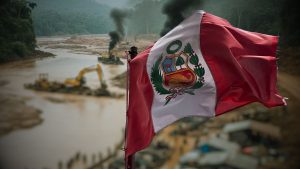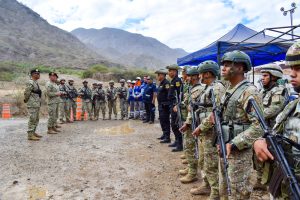Este artículo está incluido en la publicación Ambiente Estratégico 2022: Seguridad, Desarrollo y Defensa Nacional.
Summary
In the year 2021, Chile made official its claim to the maritime limits imposed in the Treaty of Peace and Friendship of 1984. This is a debate with some historical background and great repercussions at diplomatic level, between Chile and Argentina. A disagreement that almost led them to a war at the end of the 1970s and that, once again, is present, but with an air of diplomatic and peaceful mediation thanks to international law. In 2009, Argentina began its boundary demarcation process before the Commission on the Limits of the Continental Shelf, a body created by the United Nations Convention on the Law of the Sea, which approved the proposal for the outer limit of the continental shelf presented by Argentina.
Chile intends to retake what was agreed in the 1984 Treaty of Peace and Friendship to challenge what it considers to be “unilateral actions” on the part of the Argentine government. The territorial debate over the maritime boundaries that has produced altercations between these two countries makes it clear that, despite the time that has elapsed, for Chile the conflict has remained latent. In this sense, diplomatic relations between Chile and Argentina will continue to be tense until this dispute is resolved.
Key words: Continental Shelf, Maritime Limits, International Law, Dispute, United Nations.
Introduction
Argentina and Chile, neighboring countries located in the southern part of South America, share a land border of 5,308 kilometers.[1] Both are united by historically common ties and interests, which date back to the time of the Spanish conquest and expansion that organized these territories into the Viceroyalty of the Río de la Plata and the Captaincy General of Chile. Throughout the history of these countries, the geographical configuration of this border -which extends over geographical features, rivers, mountain ranges, canals and platforms- has generated crises and controversies in its delimitation process.
One of them was that of the Beagle Channel, which -in 1978- turned into a diplomatic crisis with border incidents. Thanks to the mediation of Pope John Paul II, an armed conflict was avoided between the two governments under military rule, whose conflict was exacerbated by false nationalism. In the year 2021, after 43 years of a “tense calm,” the controversy between Argentina and Chile became evident regarding the projection of their continental shelves, which intersect in an area of approximately 5,302 km2 to the southeast of these countries, a sector that many consider to be the entrance to Antarctica.[2] Consequently, the issue is of strategic importance and, as such, of political priority for both countries.
Historical Background
Argentina and Chile are bordering countries, separated by the Andes mountain range, whose territory covers the southern part of the American continent. Like most South American countries, both countries share their origins in the strong Spanish influence on the continent, although, throughout their history, differences were forged, evidenced by their customs and cultures. The arrival of the Spaniards to the American continent implied the establishment of viceroyalties to facilitate the control of the conquered territory and the administration of the resources extracted from them. In this context, the territories of Argentina and Chile initially belonged to the Viceroyalty of Peru.[3] However, in 1776, the Spanish crown decided to divide the territories of the Viceroyalty of Peru to consolidate its dominion, control its territory and maintain the flow of the resources extracted from them, in the face of the internal and external threats of the time.
On the one hand, the history of Chile began with the foundation of the city of Santiago by Pedro de Valdivia in 1540, who obtained the delegation of Francisco Pizarro to continue the Spanish conquest towards the south of the continent. With the foundation of several cities, the Captaincy General of Chile was formed, dependent on the viceroyalty of Peru, until it consolidated its independence in 1818.[4] On the other hand, the history of Argentina dates back to the founding of its capital, Buenos Aires, which was founded twice. The first, in 1536 by Pedro de Mendoza, where the complicated living conditions and the resistance of the natives of the area influenced the progressive depopulation of the city, and the second in 1580, when Juan de Garay refounded the city.[5] Later, in 1776, in view of the need to reorganize and strengthen the administration of the conquered territories for defensive and commercial purposes, the Viceroyalty of the Río de la Plata was created,[6] whose territory ceased to belong to the Viceroyalty of Peru and the Captaincy General of Chile, specifically the Corregimiento de Cuyo.[7] The towns that made up this viceroyalty secured their independence in 1816.
During the independence process in South America, Argentina and Chile were allies in this cause. Argentina was the first to achieve its independence from the kingdom of Spain. Chile followed with the help of the Liberation Army of the Andes, which sought to eradicate any kind of Spanish presence and to consolidate the independence of the new South American states. Once this objective achieved, the new states strengthened their internal political and administrative organization and established their borders. This process took time and involved border crises that were resolved diplomatically or after an armed conflict. In this regard, the territory that these new States formed was the same as that of the colonial period, since the principle of Utis Possidetis was applied, according to which the newly independent States would conserve the territory and borders established during Spanish domination.[8] It should be noted that most of the border between Argentina and Chile is demarcated by the extension of the Andes Mountain Range, as established in the 1881 Treaty of Limits.
The history shared by Argentina and Chile, like most of the countries in the region, shows a common origin of administrative and territorial organization due to the Spanish influence. Once their independence was consolidated, each sought to delimit their borders, which, despite the intention of the rulers of the time, was not delimited in its entirety. This was mainly due to the difficulties in establishing limits in certain areas or border points where the problems of establishing a meridian line, due to geography or the historical background of the place, did not allow the chancelleries or the legal system to act to settle them.
The formation of the South American states occurred in the first decades of the 19th century with the weakening and crisis of the Iberian crowns. The new countries emerged based on the internal jurisdictions that made up the colonial possessions. Thus, Argentina, Uruguay, Paraguay and Bolivia emerged from the Viceroyalty of the Río de la Plata, while Chile is an inheritance of the homonymous captaincy, and Brazil from the extinct Portuguese possessions. The objective of all the independence states was to legitimize and ensure the ascription to certain inheritances of the colonial administration, based on conflictive internal and external relations with their neighbors as well as with the European colonial powers. Since that time, there have been different territorial assemblies in a cycle of military conflicts that, in the second half of that century, allowed the consolidation of six territorial sovereignties with continuity up to the present day.[9]
Geopolitical Background
Chile consolidated its borders during the 19th century,[10] both in the northern and southern zones, using diplomatic means (especially with Argentina, through the treaties of 1856 and 1881) and military means (War of the Pacific with Peru and Bolivia from 1879 to 1884) to configure its current territory. In the twentieth century, solutions to border conflicts tended to be diplomatic, mainly through arbitration. Undoubtedly, Chilean geopolitics was influenced by the ideas of Friedrich Ratzel, referring to the importance of the growth of States through vital areas and the occupation of empty spaces.[11] This is evidenced in the position of different personalities of its history, among which we can highlight Generals Ramón Cañas Montalva and Augusto Pinochet Ugarte, and Admiral Jorge Martínez Busch. The latter’s studies, mainly his publication entitled “Oceanopolitics: an alternative for development” (1993), were incorporated into his official policy, projecting the maritime sphere as a space for Chile’s growth and development.
On the other hand, Argentine geopolitics was equally influenced by the ideas of Friedrich Ratzel, but -additionally- was influenced by Admiral Mahan, so it has maintained a permanent interest in its projection in the southern area of South America. Among the referents of Argentine geopolitics are Admiral Segundo Storni, who emphasizes the importance of defending interests through a naval policy to maintain supremacy over trade routes,[12] turning the maritime space into a means to achieve development. Another Argentine referent is Colonel Jorge Atencio, who argued that Argentina’s location in the continent is of great benefit for its economic and political development. In the same line, the studies of Rear Admiral Jorge Fraga highlight the relevance of the resources found in the continental shelf, in front of the Atlantic coasts, key elements for the future of Argentina.[13]
As can be seen, the similarity of geopolitical thinking that influenced and developed in both countries points to the search for regional hegemony which, throughout history, has involved territorial disputes due to opposing geopolitical interests, although without escalating into a military confrontation. However, these geopolitical interests remain in force and are emphasized in the maritime domain, not only for the control of ports and trade routes, but also for the strategic relevance represented by the existence of natural resources, which represent invaluable and indispensable reserves for their sustainability and development.
Diplomatic Relations Background
Diplomatic relations between Argentina and Chile are part of the relations between both States, where -despite the different political lines or profiles of their rulers- the foreign policy agenda prevails. Indeed, in an increasingly interconnected world, international integration and cooperation based on common interests is vital not only for the subsistence of countries, but also to achieve national objectives, and the longed-for development and international recognition. Although, during their republican history, both countries had disputes, they never came to a warlike confrontation. Despite this, their diplomatic relations were not interrupted, because the political decision-makers were aware that there were territorial issues to be resolved and that the best way to do so was through diplomacy and the rules governing international law.
A clear example of the use of diplomatic mechanisms to solve their discrepancies is the outcome of the territorial delimitation in the Beagle Channel area, where the use of multiple negotiation mechanisms and instances of dialogue prevailed. Consequently, political will and the use of diplomatic instruments have allowed Argentina and Chile to solve their border discrepancies and -at present- to maintain bilateral relations of cooperation and integration, focusing their efforts on strengthening their foreign policy and positioning in the region.
The Continental Shelf Dispute
As can be seen, Argentina and Chile have overcome their territorial differences through dialogue and negotiation, and their treaties have served as a basis for consolidating their bilateral relations; however, a recent event rekindled issues from the past that had been considered settled. In 2020, Argentina, by law, updated its political map, motivated by the results of studies carried out on the projection of its continental shelf. In the traditional political map, the province of Córdoba was in the “center” of Argentina; with the new map, this province is to the north and the “new center” of the country becomes Tierra del Fuego. This is verified by the change in the maritime limits beyond 200 miles and the inclusion of Antarctica in the map, even though, by international treaties, no country can exercise sovereignty over this space, allowing only scientific research activities.
This new political map of Argentina generated a reaction of rejection by Chile, whose government, in the year 2021, did the same and by decree updated its Nautical Chart No. 8, specifying the limits of its continental shelf. This action -as was to be expected- also generated the reaction of Argentina, which -through its Foreign Ministry- accused Chile of appropriating 5,500 km2 of its maritime platform and sovereignty, denouncing an overlapping of maritime space already established in the Treaty of Peace and Friendship of 1984, treaty that both countries signed as a diplomatic solution to the dispute over the Beagle Channel. Considering the aforementioned treaty, Argentina’s argument is that Chile cannot project its sovereignty beyond the agreed limits, so it only has the right to be west of the meridian 67° 16′, but not to the east.[14]
According to the United Nations Convention on the Law of the Sea (UNCLOS), to which both Argentina and Chile have adhered since 1995 and 1997 respectively, coastal states have a territorial sea and a 200-mile contiguous zone, in addition to an economically exclusive zone (EEZ) of 176 miles. However, the EEZ may be extended to 350 miles, when the continental shelf extends beyond 200 miles, with the States having sovereignty to exploit the existing natural resources, without affecting the free navigation of other countries.
Likewise, it is important to emphasize that the CONVEMAR obliges the States to resolve by peaceful means the controversies related to the application or interpretation of the same. The current controversy related to the projection of the continental shelf of both countries, disagrees due to the interpretation of the parties regarding the limits established in the 1984 treaty, because the meridian that establishes sovereignty to the east and west of it is cut at the so-called “point F”, and it is south of that imaginary point that Chile projected its maritime shelf to the east, overlapping the shelf supported by Argentina.[15]
In 1997, Argentina began to carry out maritime research work for which it established the National Commission on the Outer Limit of the Continental Shelf (COPLA), composed of a scientific, technical, and legal team to document the real extension of its continental shelf, whose results were presented in 2009 to the Commission on the Limits of the Continental Shelf (CLPC), a scientific-technical body created by the CONVEMAR. After the analysis and evaluation of this body, in 2017, the presentation was approved except for the point related to the Falkland Islands and Antarctica still in dispute and controversy.
Before the presentation made by Argentina to the UN in 2009, the Chilean Foreign Ministry sent a diplomatic note indicating that what Argentina was doing did not deserve any opinion; then, in 2017, the CLPC approved the recommendations on the Argentine presentation. During this time, Chile maintained an indifferent position until its reaction in 2020, when it began to promote a law based on the results of its investigations and redefined the outer limit of its continental shelf. The Chilean Foreign Ministry began to send diplomatic notes, with the knowledge of the UN, indicating its disagreement with Argentina’s actions and arguing that the CLCS does not grant rights between States, since it is not recognized and does not have the prerogatives of a court. Subsequently, the Chilean government, by decree, updated the Nautical Chart N° 8 where it specifies the limits of its continental shelf,[16] without the analysis and evaluation of the CLPC.
As it has been shown, the Chilean position focuses on the interpretation of the 1984 treaty that indicates that its economic zone extends as far as it is allowed by international law, with the criterion of the 200-mile distance. Therefore, it defends the legality of its Nautical Chart No. 8. Likewise, it recognizes Argentina’s right to delimit its continental shelf, but without affecting the Chilean delimitation.
Conclusions
For Chile, Argentina set its limits by the recommendations of a scientific body that does not adjudicate, nor bind rights between States. Furthermore, according to Chile, Argentina has taken actions without consultation, which is unacceptable. In this sense, Argentina and Chile have engaged in a “new” territorial dispute, affecting their bilateral relations, not seen since the one that, in 1978, almost led them to war. This situation could trigger an impact on hemispheric security. On the one hand, the solution to the Argentine-Chilean controversy, regarding the projection of their continental shelves and maritime sovereignty, could take years, given the international experiences in previous controversies. On the other hand, if no agreement is reached, the most coherent thing would be for this dispute to be resolved in an international court, as in many other cases involving similar situations.
Countries tend to preserve and protect what they consider their own, but in the face of any existing discrepancy, they should always seek a peaceful solution based on respect for agreed treaties and international law. As can be seen, the Chilean Foreign Ministry is seeking to reach a consensus with Argentina, having as a guiding light the mechanisms established in the 1984 treaty. For its part, the Argentine Foreign Ministry considers that it is too early for dialogue and negotiations, because in its opinion it is an acquired right, and they will defend it.[17] In this context, both countries will continue to maintain and defend their position, so it will be a long period of diplomatic tensions and sensitivities. It is hoped that this controversy will not reach escalations like the 1970s and will be solved through diplomatic mechanisms and within the framework of International Law,[18] because any skirmish in the region will affect the stability and the recovery process in which all countries are immersed, after the COVID-19 pandemic.
Endnotes:
- Argentine Government, “Límites fronterizos”, Argentine State Digital Platform (2022), https://www.argentina.gob.ar/pais/territorio/limites#:~:text=Longitud%20de%20fronteras&text=Bolivia%3A%20742%20km.,Uruguay%3A%20887%20km (accessed July 15, 2022) ↑
- Ignacio Grimaldi, “Chile y Argentina se disputan plataforma continental al sur de sus países”, CNN Spanish (September 2, 2021), https://cnnespanol.cnn.com/2021/09/02/chile-argentina-plataforma-continental-orix-perspectivas-buenos-aires/#0 (accessed July 12, 2022). ↑
- Peter F. Klarén, “Nación y sociedad en la historia del Perú”, Institute of Peruvian Studies, (Lima: 2004), https://www.academia.edu/16250229/251473681_Nacion_y_sociedad_en_la_historia_del_Peru_Klaren_Peter_pdf (accessed August 23, 2022). ↑
- Juan E. Mendoza, “Razonamiento Geopolítico. Construcción de representaciones y códigos geopolíticos de Chile y sus vecinos”, University of Concepcion (2017), https://editorial.udec.cl/sites/default/files/Razonamiento%20geopolítico.pdf ↑
- Ibid. ↑
- Peter F. Klarén, “Nación y sociedad en la historia del Perú”. ↑
- Ceider, “El Corregimiento de Cuyo como Institución Hispanoamericana Disciplinas”, Interdisciplinary Center for Regional Studies (2022), http://historiavirtual.mza.uncu.edu.ar/mendoza-colonial/iga10.html (accessed July 13, 2022). ↑
- National Digital Library, “Memoria Chilena 2018”, National Library of Chile (2022), https://www.memoriachilena.gob.cl/602/w3-propertyvalue-827557.html (accessed July 19, 2022). ↑
- Alejandro Benedetti, “Espacios fronterizos del sur sudamericano. Propuesta de un modelo conceptual para su estudio”, SciELO repository (June 2014), http://www.scielo.org.mx/scielo.php?script=sci_arttext&pid=S0187-69612014000100001 (accessed July 22, 2022). ↑
- Ibid. ↑
- Ibid. ↑
- Ibid. ↑
- Ibid. ↑
- Federico Rivas and Rocío Montes, “Argentina y Chile chocan por una disputa marítima en el extremo sur americano”, El País (September 2, 2021), https://elpais.com/internacional/2021-09-03/argentina-y-chile-se-enredan-en-una-disputa-maritima-en-el-extremo-sur-americano.html (accessed August 24, 2022). ↑
- Ibid. ↑
- Ibid. ↑
- Ibid. ↑
- Ludmila Cabagnero, “Reavivando viejos (des)acuerdos: territorio en disputa Argentina – Chile”, Córdoba Global Center for International Studies (2021), https://cbaglobal.com.ar/reavivando-viejos-desacuerdos-territorio-en-disputa-argentina-chile/ (accessed August 24, 2022) ↑






